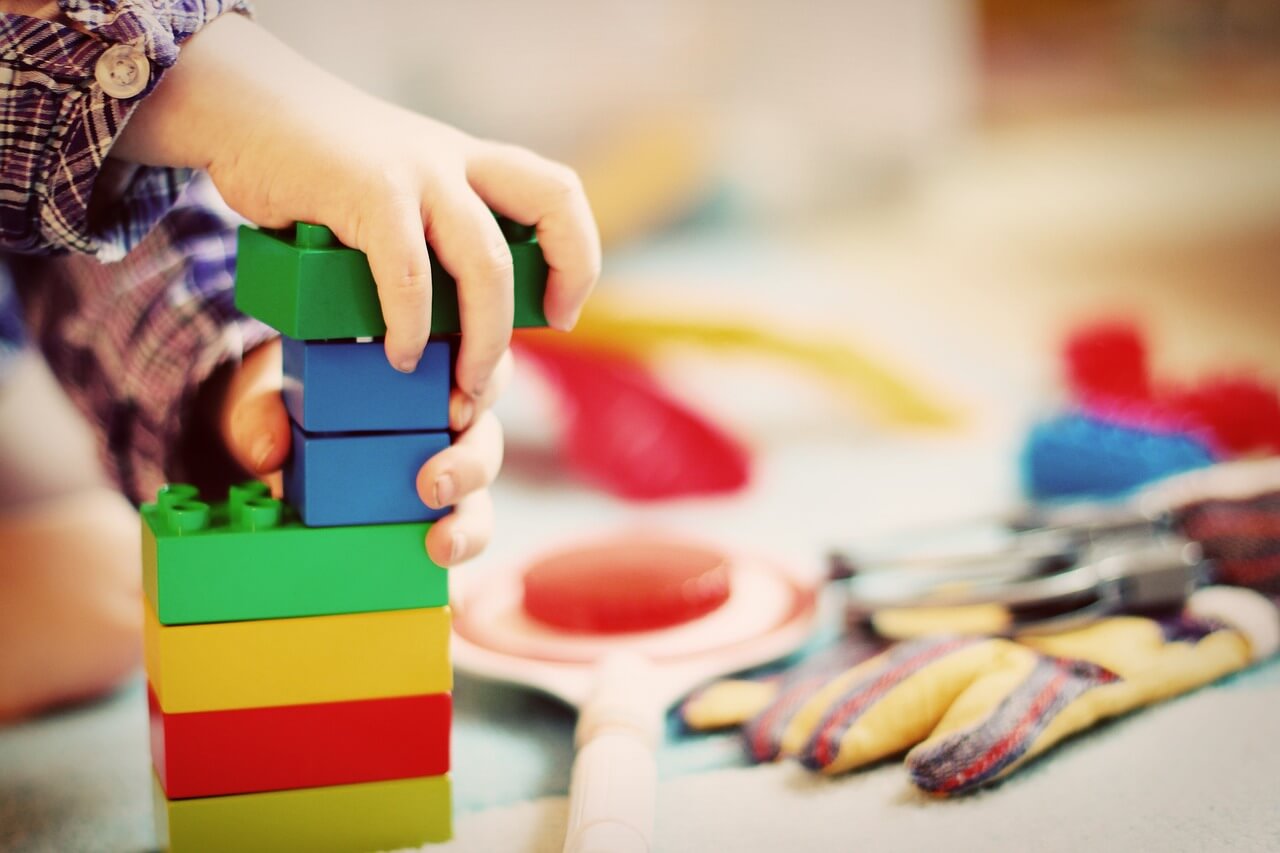Ana was observing her students during playtime. They were doing shapes and blocks so the children were quite excited and engaged. Ana saw one of her students Emman stacking blocks as high as he possibly could before the blocks collapsed. Emman squealed with laughter and tried to stack them up again.
Another student, Gestine, is playing with shape blocks and fitting them into a puzzle. Ana observes that Gestine would try to rotate the shapes to try to properly match them, then try different “holes” until the shape fitted perfectly.
What Emman, Gestine, and the rest of Ana’s students were doing is exploring spatial relationships and enhancing their spatial intelligence.
So what is spatial relationship and how does it contribute to child development?
What is Spatial Relationship and How does it help my child?
Spatial relationship, also called visual-spatial relationship is defined as the ability to identify, recognize and visualize shapes and objects, and to determine the relationship of that shape and object with other shapes and objects.
For infants and toddlers, that means recognizing faces, animals, shapes, and objects, whether two or three-dimensional, and remembering where they are, how they move, or how they fit in relation to other objects. When you will see babies and toddlers reach for toys, stacking blocks, and recognizing shapes, that is how they are establishing spatial relationships.
In teenagers and adults, it means imaging shape in different visual perspectives – like imaging how an object will look if rotated or modified.
What most people don’t know is that spatial ability and relationship is a mathematical skill. Just like when a child identifies the shape of an object, he is learning math – geometry. When children are caught in a predicament of not being able to fit shapes into the block, they are learning math and improving their problem-solving skills. When they try to move an object from one place to another, they are learning math – measurement, and distance.
While it is natural for children to show interest and curiosity in objects around them, we as parents, teachers, and caregivers can help develop this skill.
Benefits of improved spatial intelligence
Nurturing and developing spatial awareness early on improves a child’s organization skills (fitting all blocks in one box, or playing with puzzles), sense of location and navigation (finding and remembering the location or placement of items), and communication (communicating the location of objects like “under the chair” “on the table” etc.).
Studies have shown that young children who develop their spatial ability early on, and when such skills are nurtured, are more likely to improve on STEM (science, technology, engineering, and math), and secure jobs, and perform well in visual arts, business, and STEM-related fields.
So how does spatial intelligence, awareness, and relationship look like in child development? At what stages do these skills start to manifest and when can we expect an infant to show?
Spatial Relationship in Child Development
Children are naturally curious and will try to explore objects in their environment on their own.
The first 24 months of a child is crucial in expanding spatial relationships. In Piaget’s theory of cognitive development, this stage, also known as the Sensory Motor Stage, is a period of rapid cognitive growth and is where children develop the 5 senses through movement and experience.
This exploratory stage is where babies become more aware of their body and their surroundings. They recognize, follow, experiment, and work around different objects in their environment. You will be able to see different actions and reactions of how a child navigate through their environment. This is the main milestone in this period.
This stage is also where an infant will recognize object permanence. Object permanence is a concept where when the object is not in the line of sight of a child, he or she knows that it did not disappear, but is only in a different place.
And as a child grows, it continues to accumulate experience. Through trial and error, he learns how far he needs to stretch his hands to reach for his feet or for a toy. This awareness of the body is called proprioception, and with each attempt, the child must get a better sense of the position of his body in space.
An example would be a parent hiding a ball and the child knows that the ball did not disappear even when he can’t see it.
As parents, it is better to teach them early because they need these skills in school admission tests, program placements, and kindergarten. Usually, schools require them to draw lines and shapes as these are building blocks of writing letters and numbers.
0-12 Months
As soon as infants open their eyes, they can already identify face-like shapes and moving items.
Babies will start following moving objects either by sight or by crawling towards it, such as following a ball, a toy car, playing chase with parents, or following mobiles in cribs and walkers.
They will also start touching, shaking, and patting toys, and putting things in their mouths.
As babies reach around 6 or 7 months of age, their spatial awareness will expand and their distance vision has improved, wanting to reach to items around them.
Around 8 months to 10 months, your baby should be able to recognize when you took a toy or an object away from him and will follow it with his line of sight.
Activities:
As early as possible, it is best to introduce objects of different shapes, colors and sizes to children as they become aware of their surroundings.
Provide toys that have different visual and auditory aspects such as rattles, mobiles, and musical toys. Also, introduce toys the child can move around and stacked around such as shape blocks and nesting cups.
Provide spaces where your child can move around, such as padded playpens. It is also best to let your child explore outside to explore and expand their spatial awareness.
While doing all this, communicate with your child – using descriptive and positional words they can mimic and understand.
12-24 months
Children will begin to see and understand how objects fit with each other. This will continue until about their 24th month, where they will start putting objects in places and containers, using one or both hands, and will start solving simple puzzles.
They will also start understanding and saying descriptive words (such as big or small), directional, positional, and simple prepositions (such as under, on top, behind, etc.), and categorizing objects either through color, shape, or size. In addition, they will start recognizing parts of an object (like the wheels of a toy car) and its orientation.
Once they start to crawl, they will be able to navigate through obstacles like going behind the chair or climbing through the couch to reach something.
Activities:
In addition to introducing building blocks of different shapes, try introducing simple puzzles and other problem-solving pieces, all while avoiding frustration. Start giving directions that they can understand.
At 12-24 months, as their motor skills and curiosity about objects and environment grow, introduce more complex puzzles and building blocks. Start describing everyday objects around you when you go for a walk, watch TV, or play with toys.
Create safe spaces and obstacle courses to which they can move around.
24-36 Months
From 24-36 months, children will further develop their spatial skills, along with the vocabulary they acquired during their early infancy.
Because they are more familiar with the shapes and their surroundings, they can perform simple puzzles faster. They can stack blocks or create a train of blocks or string beads or blocks together.
As their vocabulary expands, they will use more words and gestures to describe objects and their corresponding locations. You will also see your child climbing and moving a lot in relation to its surroundings. Your child can hold a pen or a crayon and can copy you as you draw lines and shapes.
Activities:
Once they start talking, let them identify shapes by themselves. Draw shapes using highlighters, or play connect the dots. Continue giving puzzles and games that further develop their cognitive abilities.
Toddler Years
As children enter the toddler years, they become more curious about themselves and their surroundings. They will start associating objects as symbols of something and will have intuitive and imaginative thoughts, thinking that objects, and/or having imaginary friends.
Activities:
Continue giving an environment to enhance their spatial ability. Give toys that they can use to build structures, such as Legos and puzzles, and tasks that enhance their problem-solving abilities.
Also, start introducing mathematical concepts early on to further develop their imagination and spatial abilities. Introducing games also is said to boost the spatial intelligence of children.
Related Read: What to Put in Easter Eggs for Toddlers: Small Toys & Healthy Treats
Spatial Awareness deficits – Signs and Therapy
Every child is different and their timeline may vary between other children. As such, spatial awareness may manifest at different ages.
However, if you notice that your child is not showing any signs of may be slower than others, then it may, again emphasis on the “may”, have spatial awareness deficit.
A child with poor spatial awareness will have difficulties with visual perception. Visual perception is about how a child makes sense of his surroundings based on what he sees. A child with poor visual perceptions will have difficulties reaching into objects or keeps bumping into things.
This deficit may be just a delay in development or it may be something serious like visual impairment, dyspraxia, or autism. Therefore it is best to consult with your trusted health care professional.
Some children with spatial intelligence/awareness deficits compensate for this with other skills. Others have strong auditory memory skills or verbal comprehension. Some may also have better verbal and non-verbal reasoning skills. Again it may differ with each child so it’s best to consult with your trusted health care professional should you worry that your child may be experiencing spatial intelligence deficiency.
How to develop spatial relationships for children with spatial awareness deficits
The good news is that deficits in spatial relationships can be improved through therapy. Therapy includes observing your child’s motor skills such as engaging them to play with different toys and games.
At home, continue to play with the same activities to develop their spatial intelligence. Also, you can add the following activities to further develop their sense of space and direction:
- Hide objects and ask your child to look for it with certain instructions
- Test your child’s sense of space by asking him which object is near and which object is far
- Test your child’s sense of direction by asking him to turn right, up the stairs, under the table,
- Let your child play in the park or jungle gym
- Let them play with building blocks
How to continuously monitor your child development?
When you decide to have a babysitter or enter your child into a daycare center, it is important that these skills continuously develop.
At Clever Bee, we engage your little ones with different yet fun activities that will help them develop spatial awareness and intelligence to improve spatial relationships with their surroundings. Learn more about our programs for babies, toddlers, preschool, and before and after school by calling us or visiting our contact page.








